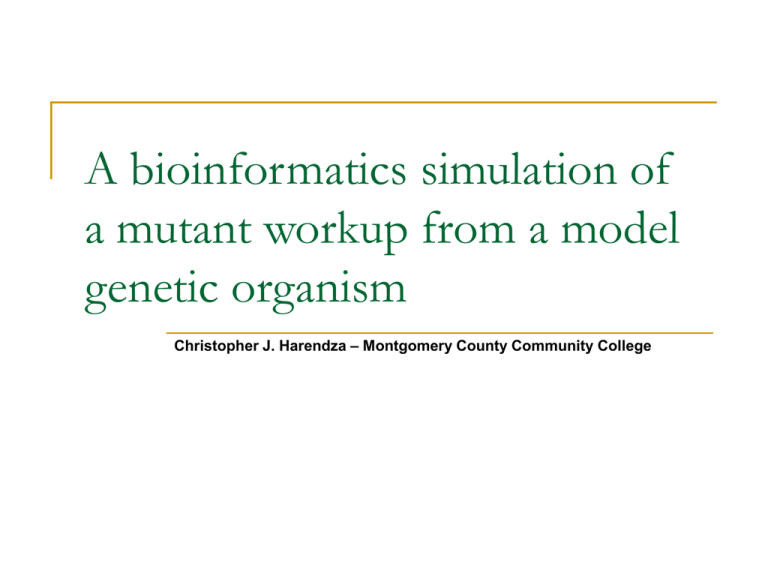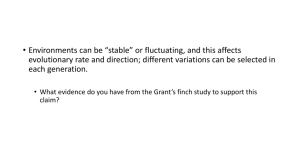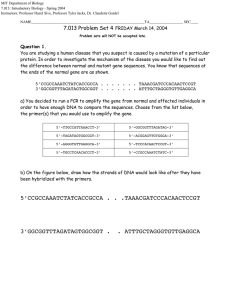A bioinformatics simulation of a mutant workup from a model genetic
advertisement

A bioinformatics simulation of a mutant workup from a model genetic organism Christopher J. Harendza – Montgomery County Community College Importance Students are losing the appreciation for the power of traditional “forward genetic” approaches and a situation is arising where most everything is mass “stare and compare” informatics and reverse genetics While the new approaches are very powerful, full scale mutant screens have and should continue to be important Example Nusslein Volhard, who did a full scale saturation mutagenesis to identify developmentally important genes in Drosophila, is now doing similar work with Zebrafish “Genetics (mutant analysis) is the window to the unknown” -Christopher Harendza, not a famous person. Ha ha Objective Introduce students to the power of traditional genetic analysis of mutants and extrapolate this to bioinformatics tools on the web Target Audience: Students in a sophomore genetics class Advanced freshman biology majors Overview Give students model data on a real mutant using, Drosophila, C. elegans, etc. This data could parallel a wet lab, or series of wet labs, where students learn the techniques, but can then do concordant studies with informatics tools Flow chart Flow chart of the project Give students a collection of mutants ↓ Allow groups to choose a mutant of interest ↓ Groups perform a series of crosses to establish linkage -use Virtual Fly to obtain real data ↓ Students design appropriate 3 point cross to map the gene Go over strategies to clone the gene (here is where corners would have to be cut) e.g. positional cloning e.g. P-element cloning by complementation etc. ↓ Instructor provides the DNA sequence data ↓ Students do bioinformatic analysis Informatics phase DNA SEQUENCE Find homologs in fly cDNA library database BLAST Generate restriction enzyme map (do this backwards) cDNA and application The gene of interest would likely be eukaryotic and therefore possess introns Therefore obtaining the cDNA is vital Use the cDNA to identify open reading frames and translation tools to infer the amino acid sequence of the protein Blast applications BLAST Find orthologs Go to OMIM to find information on human ortholog Do Clustal analysis to compare to known proteins BLAST Use the sequence to find orthologs in other organisms Ask questions regarding conservation of function Work up to human, if applicable, to find cognate genes Clustal Analysis Once orthologs are obtained, students could establish a database and compare related gene products Discuss evolution of function Protein analysis Go to Protein Data Bank to find orthologs or a protein (s) in the same gene family If someone has solved the structure of this or some related protein, structural analysis could be performed OMIM Application Human applications would be the ultimate “hook” to draw in the interest Students could then analyze the orthologous human gene At this point they would have access to a tremendous wealth of information Discussion of future applications Reverse genetic approaches in mouse models (knock outs, knock ins) Biotech applications Gene therapy Summary This activity will expose students to an authentic research simulation while preserving the traditional discussion of genetics Curriculum evolution Wishes It would’ve been nice if others at the workshop had interest in this project and I could stay for the last session; lack of interest makes me think it may not be such a good idea! A trial run this term with my newfound tools will allow assessment of its efficacy








